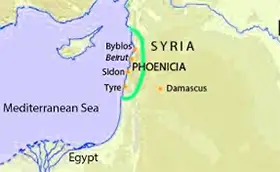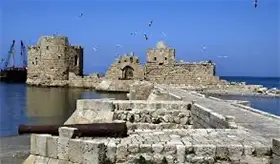Ancient Sidon
Sidon was one of the three great Middle Eastern cities of the Phoenician culture, the other two being Byblos and Tyre. People were living in Sidon from about 4000 B.C. 
Sidon was actually a greek name (meaning "fishery"). The people who lived in the city called it Sidonia or Saida. They were famous for their glass-making and for the manufacture of purple dye that became associated with royalty. Tyre, too, produced this dye, gotten from Murex shellfish. As was the case in Byblos and Tyre, Sidon excelled at shipbuilding and at maritime trade. Nearby Egypt was one of Sidon's biggest customers; and many historians think that Sidonians taught Egyptians to use faience. Archaeologists have found Sidonian artifacts in locations near and far, from Egypt and Mesopotamia to Rome and even as far away as Britain. Another of Sidon's neighbors was Ancient Israel. In the 9th Century B.C., King Ethbaal of Sidon gave his daughter Jezebel in marriage to King Ahab of Israel, to cement a political alliance between the two civilizations. This agreement lasted for a time but ended with the overthrow of Ahab's rule. Sidon, like the rest of Phoenicia, came under the sway of various kings of the Assyrian Empire, in the 7th Century B.C., and of the Persian Empire in the 5th Century B.C. 
Another nearby Phoenician city, Tyre, grew in importance and, primarily through its production of the purple dye that made it very famous, eclipsed Sidon in fame and wealth. The leaders of Tyre drew the ire of Alexander the Great, however, and found themselves conquered in 332 B.C. Sidon avoided the same fate by earlier surrendering to Alexander without a fight. The last conqueror of Sidon in ancient times was Rome's Pompey the Great, who arrived in 64 B.C. and claimed Byblos for Rome. |
|
Social Studies for Kids
copyright 2002–2024
David White




